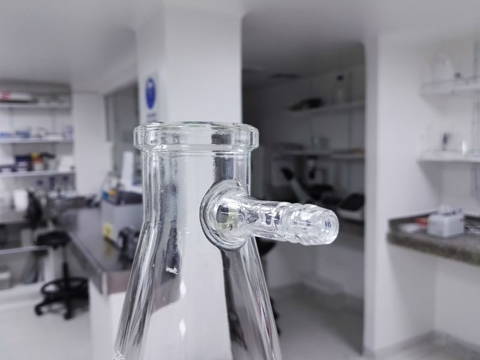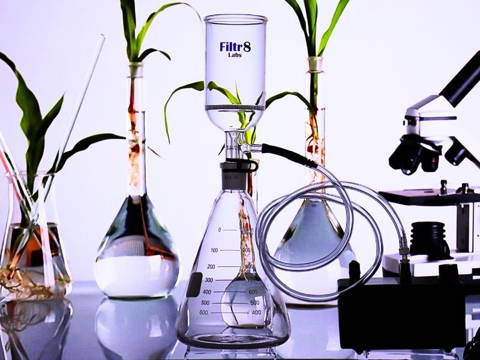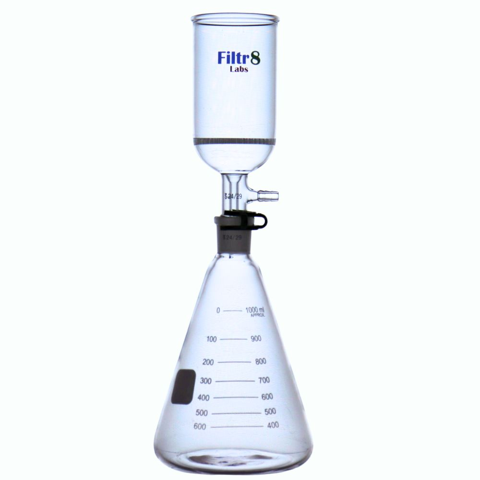Buchner Flask Kits
Filtration for Small Labs
Buchner Flask Kits
Small Lab Filtration
Free USA Delivery/ Returns
12-Month Warranty
One Day Handling Time
Free USA Delivery/ Returns
12-Month Warranty
One Day Handling Time
Free USA Delivery/ Returns
12-Month Warranty
One Day Handling Time
What is a Buchner flask?
A Buchner flask, sometimes called a vacuum flask, is a specialized laboratory glassware commonly used in filtration processes. It is named after its inventor, Ernst Buchner, a German chemist.
The flask is a thick-walled, round-bottomed filter flask or Erlenmeyer flask made of borosilicate glass. It typically has a tapered neck and a short, vertical tube, known as the sidearm, which is connected to a vacuum source via an adapter and tubing. A Buchner funnel connects to the flask with either a rubber stopper or a ground glass joint to create a leak-free seal. The funnel may be made of borosilicate glass or porcelain is designed to hold a filter paper atop a perforated or fritted glass plate.

The primary purpose is to facilitate vacuum filtration. When set up for filtration, a vacuum is applied to the sidearm of the flask, creating a pressure difference between the inside and outside of the flask. This pressure difference causes the liquid mixture to be drawn through the filter paper, leaving behind the solid particles or precipitates on the filter.
Buchner flasks are commonly used in various scientific fields, including chemistry, biology, and pharmaceutical research. They are particularly useful when dealing with large volumes of liquid or when the filtration process needs to be carried out under reduced pressure. The Buchner vacuum filtration setup allows for faster and more efficient separation of solids from liquids compared to traditional filtration methods.
In addition to filtration, Buchner flasks can also be used for other laboratory procedures, such as solvent extraction, recrystallization, and drying of samples under vacuum. They are versatile tools that are essential for any well-equipped laboratory collection of glassware.
To set up a Buchner funnel for filtration, start by placing a filter paper or porous filtering material on bottom surface of the funnel. The size of the filter paper should fit snugly inside the flask to ensure a tight seal. Next, connect the sidearm of the flask to a vacuum source, such as a vacuum pump or aspirator. Make sure the connection is secure to prevent any leaks.

Once the setup is complete, turn on the vacuum source to create a pressure difference inside the flask. This pressure difference will draw the liquid mixture through the filter paper, while leaving behind the solid particles or precipitates. The filtered liquid can then be collected in a separate container for further analysis or processing.
After filtration, it is important to properly clean and maintain the Buchner flask to ensure its longevity and optimal performance. Rinse the flask with water or an appropriate solvent to remove any residual substances. Avoid using abrasive cleaners or brushes that may scratch the glass. Allow the flask to dry completely before storing it in a safe place.

Buchner Flask Kits for Small Labs
Elevate your lab efficiency. Our flasks are made from borosilicate glass paired with an oil-free lab vacuum pump allows for hand-free filtration. While filtering, you can perform other tasks to increase productivity... free from hand pumps. Our high quality filtration kits are great for small labs, schools, or home use. Just flip a switch and up your filtration game.
Our Buchner Flask Kits have ground glass joints instead of a rubber stopper for easy assembly, disassembly, and cleaning. Integrated glass plate with uniformly spaced hole provides a stable base for your filter media, and allows for even flow distribution across the media.
PRODUCTS

